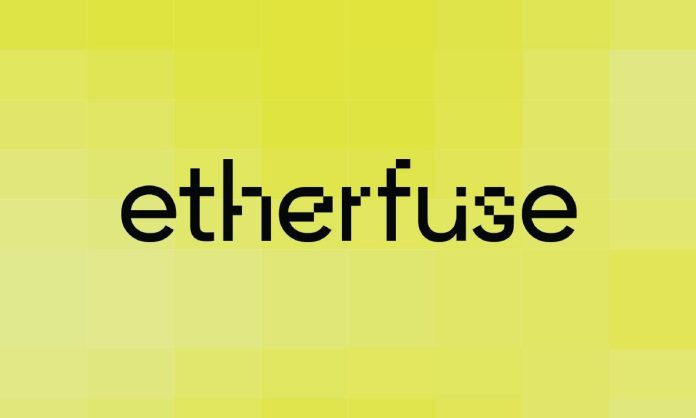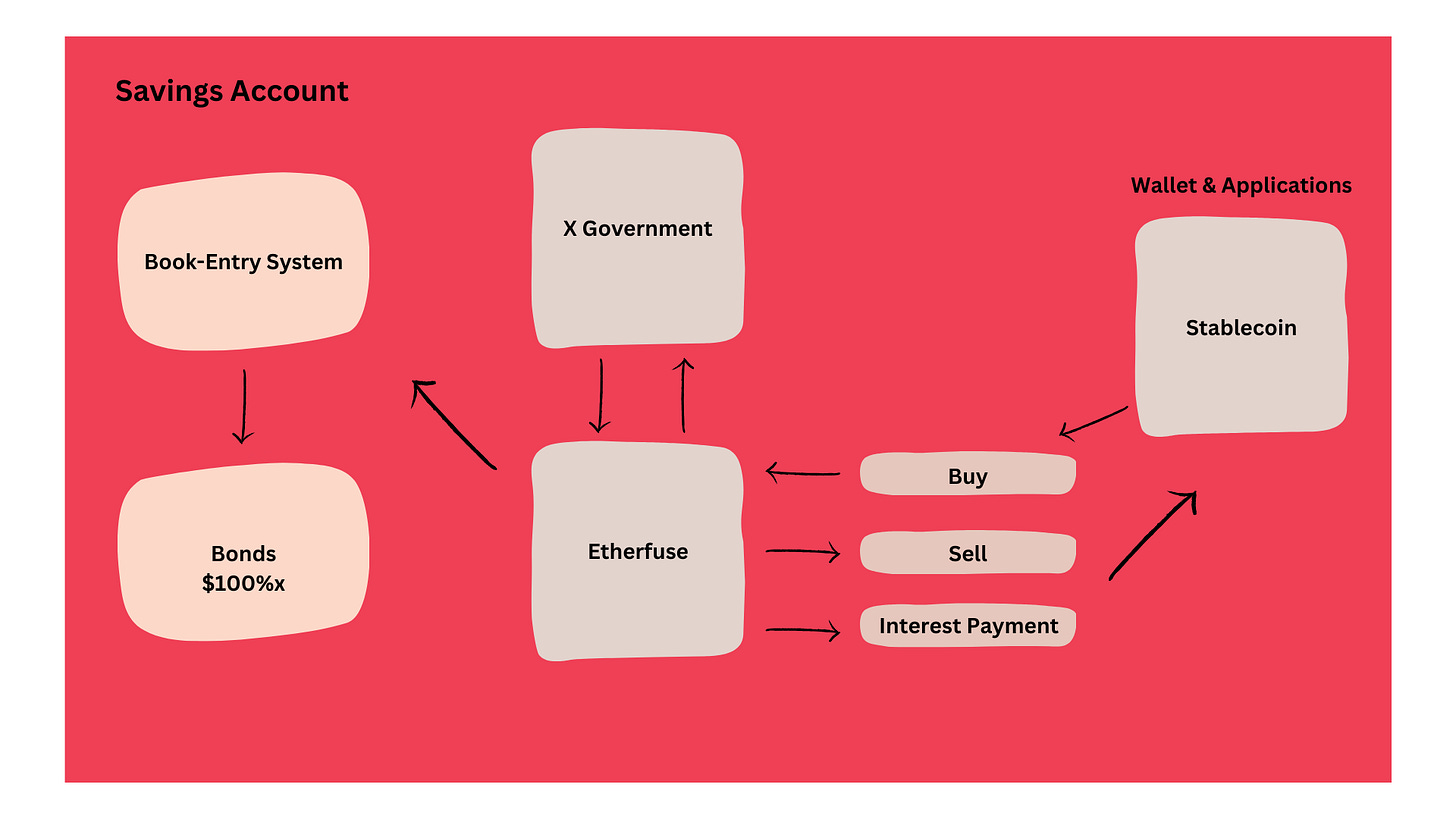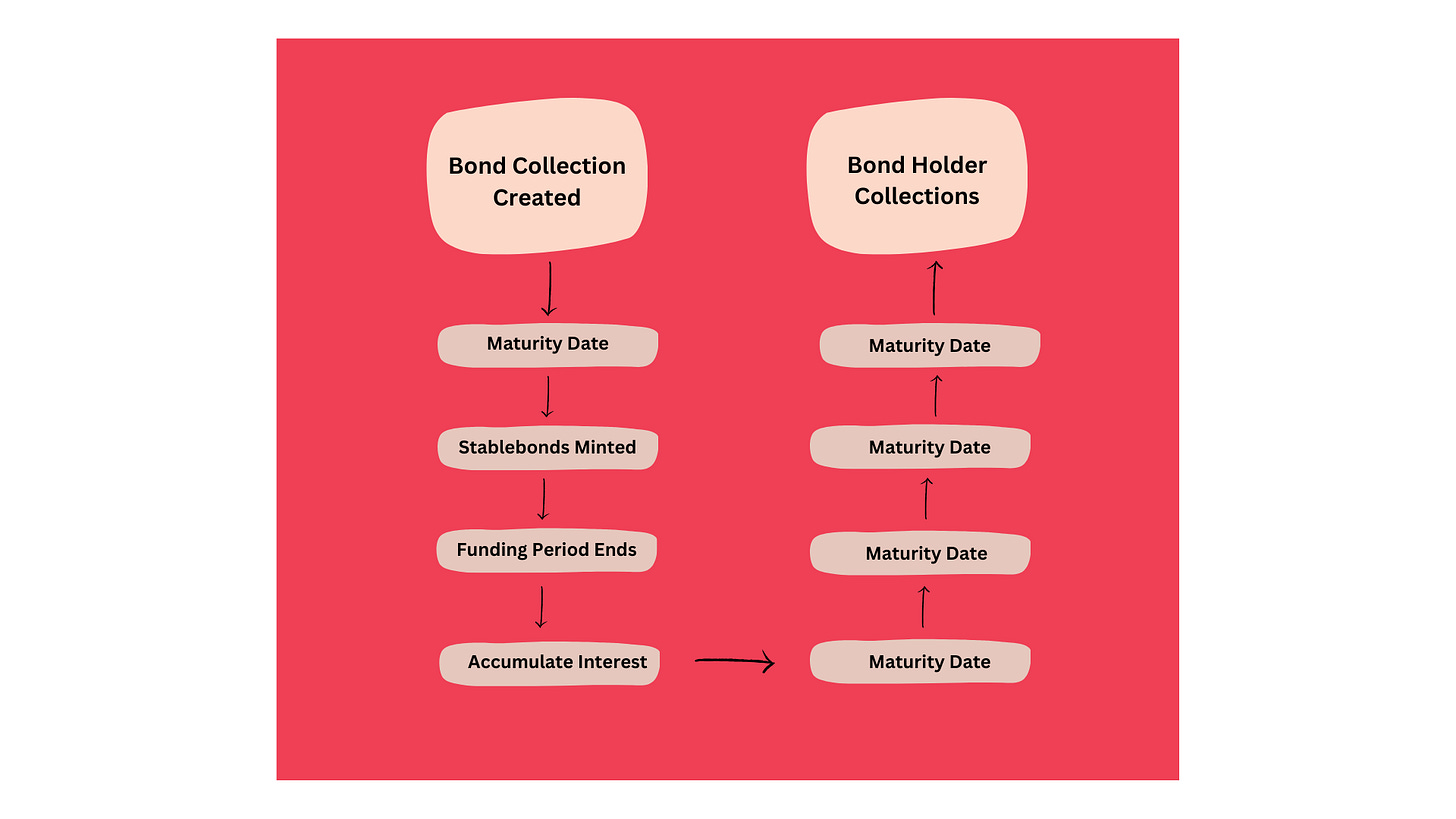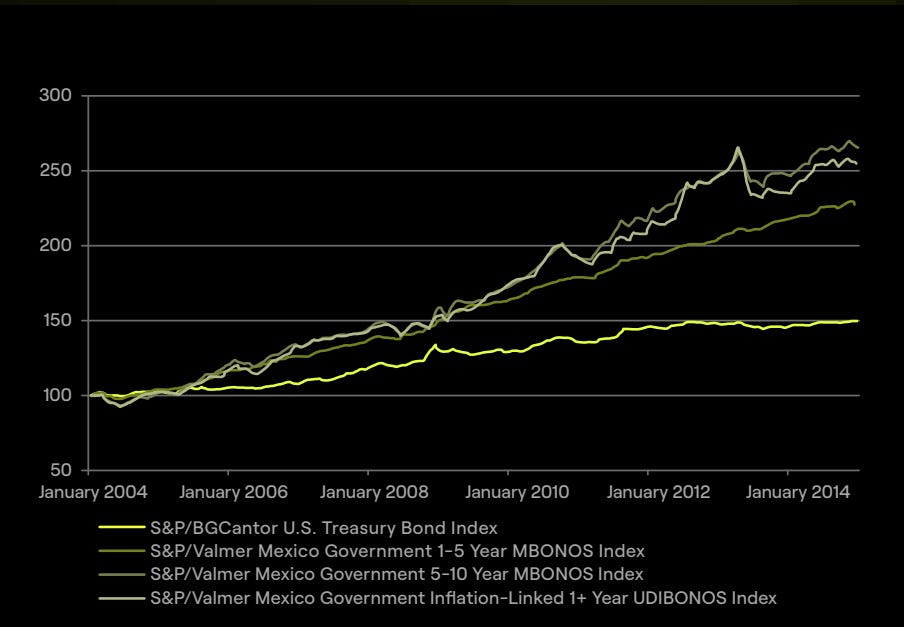Decentralizing Bond Market
How Etherfuse is bringing Stablebonds as a Collateral to DeFi Ecosystem
“Global Tokenization market could reach $16T by 2030” — A report by the Global Financial Markets Association (GFMA) and Boston Consulting Group (BCG).
Real world tokenization started emerging in 2023. As per DeFiLlama, it stands at $6.42B in TVL.
Real World Assets bring any off-chain (real world) financial assets on-chain. These assets can be Treasury bills, Green bonds, Real Estate, Credit, and Commodities like Art, Gold and even Whisky!
Why there is a necessity for Real World Assets on-chain?
Tokenization of real world assets does help in creating the followings:
Global by nature — Crypto operates across borders, inherently designed for a worldwide financial system
Always accessible — Unlike traditional finance, crypto markets run 24/7, without interruptions
Programmable assets — Tokenized assets can be programmed to automate contractual terms, enabling efficient tracking and execution of financial agreements
Composable — DeFi has the ability to connect and interact with multiple protocols simultaneously, unlocking powerful integrations
In this essay, we will touch on Bond market and how Etherfuse is offering the stability of traditional bonds with blockchain technology. We will also explore other projects that offer similar services in this space.
Bonds has been playing a pivotal-role in national building throughout history. It had served as tools for defense, development and debt management. These financial instruments have incentivized both sovereign governments and individuals to support the growth of emerging currencies.
Blockchain technology has the potential by tokenizing assets, to create innovative financial instrument that combines the stability of bonds and accessibility of crypto market. One such instrument is — Stablebonds. Stablebonds are positioned to drive cryptocurrency adoption while adhering to regulatory frameworks.
Stablebonds are tokenized real-world assets (RWAs) backed by government-issued bonds from stable countries like USA, Mexico, and the European Union. These bonds act as a backbone of Stablebonds, ensuring security on returns as it combines best of both worlds — consistent income and real asset backing.
Typically Stablebonds offer yields ranging between 3% and 9%, depending on the specific bond you choose to invest in. The returns gets adjusted weekly to ensure your returns remain competitive with the market conditions.
If it’s for stability, crypto has Stablecoins right? Why does it need Stablebonds?
Initially, Stablecoins have emerged as a cornerstone of cryptocurrency ecosystem, providing a reliable, stable medium of exchange amidst the volatility of other crypto assets. Among the three primary types of stablecoins (fiat-backed, crypto-backed, algorithmic)— fiat-backed stablecoins like USDC have proven to be most practical, offering high utility and low barrier to entry.
Fiat-backed stablecoins maintain their stability by pegging each token to an equivalent amount of fiat currency, such as US dollar.
Let’s take Circle as an example which has established itself as leading stablecoin issuer.
To maintain its peg, Circle secures substantial reserves - $11.5B in US bank deposits and $31.5B in US Treasury Securities as of November 2022. This approach not only ensures USDC’s stability but also generates significant returns for Circle, amounting to an estimated $620M annually, all while indirectly supporting US intersect through Treasury purchases.
Taking the recent data, Circle maintains reserves of $36.9B while circulation of USDC is at $36.7B. Therefore, Circle issues USDC stablecoins by selling each token for $1 and backing it with equivalent reserves in cash and US Treasury securities. These reserves generate interest income while ensuring USDC remain stable and redeemable at any time.
However, this model has issues: while USD-backed stablecoins are widely adopted, the value generated from these fully dependent on the economic stability of United States. For users in other countries, relying on USD-backed stablecoins can be risky, as it creates dependency on a centralized country issuing its currencies. The portfolio of the Circle Reserved Fund contains short-dated US Treasuries, overnight US Treasury repurchase agreements, and cash (custodied by The Bank of New York Mellon which is managed by BlackRock). So, when a user purchases or store 1 USDC for $1, they accept the risk and exposure to the US banking system. Isn’t it ironic to the idea of crypto??
To solve this issue, one interesting project with Stablebonds offerings that I have come across is Etherfuse!!
Etherfuse
Etherfuse offers stablebonds that are tokenized representations of sovereign bonds issued by individual nations or sovereign nations. This financial instrument allows nations to engage directly with crypto economy while retaining value created by their citizens within their own borders. Etherfuse has been deployed on Solana blockchain. Solana DeFi is one of the most vibrant market with $5B in daily volume trading.
Etherfuse facilitates the process by purchasing sovereign bonds, issuing stablebond tokens equivalent to the bonds held (similar to Circle’s cash reserves) and manages these tokens throughout the lifecycle of the bond. As the sovereign bonds pays interest after maturity, Etherfuse distributes to stablebond holders in tokenized formats.
Stablebonds can leverage the usage of cryptographically secure algorithms to eliminate the intermediaries and their associated risks in financial transaction. This technology removes the reliance on a sovereign nation’s building system.
Etherfuse maintains a book-entry system of bonds, to decouple fiat-pegged cryptocurrencies from local banking systems. This addresses the vulnerabilities that have historically led to debt defaults.
Stablebonds offer a powerful and innovative alternative to fiat-backed stablecoins.
It reduces the exposure to the risks of foreign banking systems
Stablebonds enhances the accessibility of safe financial instruments — enabling retailers to participate in wealth-building through secure, transparent mechanism
Apart from these, Stablebonds offer: (1) fractional ownership over bonds for high liquidity, (2) improving fungibility through DeFi trading pairs, and (3) access to global market
Stablebonds not just expands market demand for local assets, but also allows access to individuals worldwide on financial products with just a decentralized wallet.
So, what is special about Etherfuse? Does it provide a unique yield bearing opportunity unlike other traditional DeFi financial instruments?
Interest-based Opportunities on the Blockchain
We have DeFi-based financial instruments that helps users generate yield on-chain. These yield-based mechanisms are liquidity provisions or on-chain loans. These methods have risks like impermanent loss, token devaluation or counterparty failure.
Impermanent loss is the loss for liquidity providers (LPs) who might experience when they supplied assets to DeFi liquidity pools, instead of just holding. To better understand impermanent loss, check out the article by Ston.fi.

Impermanent loss is a significant risk for liquidity providers in the DeFi space, especially when dealing with volatile or poorly designed assets.
Etherfuse addresses this by implementing Stablebond program that integrates safe and intuitive access to bond markets via decentralized wallets. This solution provides interest-bearing, lower risk alternatives to traditional DeFi yield opportunities, catering to users seeking more stable and secure financial instruments.
Bond Offering Mechanism
Etherfuse operates as a bridge between government-issued bonds and the decentralized world of stablecoins.
Etherfuse is powered by on-chain smart contracts, which defines the bond’s characteristics through embedded metadata. During the initial funding period, users can purchase Stablebond tokens that corresponds to specific bonds. These Stablebonds are Etherefuse Bond Token (EBT), a specialized token based on the Solana (SPL) Token-22 standard (or Token Extensions). Once this funding closes, the bonds begin to accrue interest, and no further tokens can be minted or purchased. Any unsold Stablebond tokens are retained in Etherfuse’s treasury until maturity.
Therefore, to simply put, Government sells bonds, which Etherfuse acquires them. Then these bonds are entered into Etherfuse’s book-entry system, enabling digital management and tokenization. Etherfuse tokenizes the bonds into Stablebond tokens, allowing users to purchase them in exchange for stablecoins. Interest generated from the bonds is distributed back to Stablebond holders via their wallets. Upon bond maturity, Etherfuse burns (eliminates) the Stablebond tokens and distributes the final bond value (principal and remaining interest) to holders.
Etherfuse offers two primary types of bonds: (1) Coupon Bonds and (2) Zero-Coupon Bonds.
Coupon Bonds provide periodic interest payments at predetermined intervals, giving holders consistent returns throughout the bond’s lifecycle.
Zero Coupon Bonds are sold at a discounted prices and do not pay periodic interest; instead, bondholders receive the full face value upon maturity. This dual offerings allows Etherfuse to cater to a broad range of investors with varying financial goals and timelines.
Etherfuse Bond Token (EBT)
EBT is an interest-bearing token governed by the specific characteristics of each bond collection and the demand during the funding period. Etherfuse has full control of the minting authority of EBT, ensuring that token issuance aligns with the bond’s predefined parameters, contributing to a highly controlled secure ecosystem.
Just to get a sense:
Without EBT: If you wanted to invest in a government bond, you need to go through a bank or financial institution, buy the entire bond or a large portion, and manage it, which cannot be done by an individual.
With EBT: Etherfuse purchases the bond, tokenizes it into EBT, and you can buy a small fraction (e.g., $50 worth of EBT). You’ll see interest accumulate in your wallet, and at maturity, you’ll receive your $50 plus interest — all without needing a bank or intermediary
So, with EBT, we get to have following upsides:
Decentralization of Traditional Bonds: By tokenizing sovereign bonds, Etherfuse enables decentralized access to traditionally exclusive financial instruments.
Low-Risk Yield Generation: The reliance on government bonds offers a low-risk alternative compared to volatile DeFi protocols, making it appealing for risk-averse investors.
Financial Inclusion: The mechanism eliminates the need for third-party intermediaries like banks, providing individuals with direct access to financial tools through decentralized wallets.
Transparency and Security: On-chain smart contracts ensure transparency and automate the entire process, minimizing errors or fraudulent activities.
Diverse Offerings: Supporting both coupon and zero-coupon bonds enables Etherfuse to cater to various investor profiles, from those seeking regular income to those prioritizing long-term growth.
Centralized Mint Authority: The decision by Etherfuse to retain full control over the minting process for Stablebonds. This must be downside as it’s opposite to the whole mechanism of decentralization. However, if this aspect of the mechanism becomes decentralized, anyone could mint Stablebonds which may increase the risk of uncontrolled issuance, fraud or legal issues. The approach of centralization with this aspect can mitigate risks of over-supply, market manipulation and regulatory non-compliance, as this can allow Etherfuse to comply with existing and future regulations — KYC.
The upsides are huge with the offerings Etherfuse brings on to the table. But if you ask me downsides, here are my thoughts:
Although the risk of banking system is reduced, the mechanism still depends on the economic and political stability of sovereign nations issuing bonds. So, the economic stability of the nation is a crucial factor which is to be gauged.
Liquidity Concerns: If market demand for these tokens is low, it may result in unsold tokens sitting in its treasury, that would potentially impact liquidity problem.
Bonds Payment Structure and Lifecycle
The Stablebond system operates through a structured payment process that aims to provide users with both flexibility and security. When a user mints Stablebonds on Etherfuse platform, the funds from the minting process are directed to Solana Program Derived Address (PDA) that served as the funding account for the Bond Collection.
This process ensures necessary funds are collected before any bonds are purchased by the sovereign entity. The designated Bond Administrator is responsible for transferring funds to the sovereign, facilitating the purchase of bonds 1:1 basis.
The interest payments are made periodically to the holders of EBT holders. These payments are credited to the program’s designated interest payment account, with conditions outlined by the bond terms.
Upon maturity of the bond, the principal amount is transferred to a dedicated principal account, where it is made to the EBT holders.
Bond Redemption
Etherfuse designed the redemption process to be flexible and offering various choices to user’s preferences.
First, bond holders can redeem the par value of their bond along with any applicable coupon payments through the Etherfuse web client. Once the bond is redeemed, the equivalent EBT tokens are burned, and the user received stablecoins that is linked to the bond. This process is seamless and securing the bond into more liquid asset.
Second, for users who prefer to liquidate their bond before maturity, Etherfuse offers them flexibility within the Solana ecosystem. Users can exchange bonds in marketplace, allowing them to tap into liquidity of Solana’s DeFi system. This will enahnce capital efficiency and provides more options to users according to their financial needs.
Third, for users who would like to follow the traditional approach, Etherfuse allows them to earn interest on their bonds prior to maturity. In this case, the interest is paid, the original EBT tokens gets burned and replaced with newly minted NFTs that represent the interest collected and the remaining balance owed to the Stablebond holder.
Users can continue this process of converting EBT tokens into NFTs to collect interest payment until bond reaches its maturity. Once the maturity is completed, the NFT gets burned and user gets full par value along with any remaining coupon payments, in the form of fiat-pegged stablecoin.
Par value is nothing but face value or stated value of a bond. It represents the amount the bondholder gets from the issuer at maturity, excluding interest payments (or coupons) made during the term.
Fourth, for users who prefer to maintain more straightforward approach can simply hold their EBT tokens and redeem for the principal and coupon payments at maturity, avoiding the need to interact with NFTs.
With multiple options for its users in redeeming the bonds, Etherfuse offers both short-term liquidity and long-term savings opportunities, catering to the various preferences of user needs.
The lifecycle of the bond ensures transparency and efficiency in managing bond-based financial instruments on the blockchain. The process begins with the creation of a Bond Collection, followed by the minting of Stablebonds tied to this collection. During a limited funding period, users can purchase these tokens, after which the bond start accumulating the interest until the designated maturity date. Upon maturity, bondholders redeem their tokens for the pat value and any accrued interest. As mentioned earlier, the redemption process involves burning of EBT tokens, completing the lifecycle.
Sovereign Coins
Etherfuse in response to the current challenges with Stablecoins, has introduced the concept of Sovereign coins. Sovereign Coins are positioned in offering a community-focused alternative to traditional stablecoins. While USDC, USDT are being widely used, they are predominantly issued by centralized entities, concentrating economic gains within foreign institutions and corporation.
Sovereign Coins, backed by Etherfuse’s Stablebonds, present a solution that redirects economic rewards to communities, enabling the users to capture yield from government-backed bonds rather than relying on transaction fees or centralized issers.
Sovereign Coin protocol addresses several issues of Stablecoins.
Depegging risk
Lack of transparency in reserve verification
Significant technical and financial barriers for new users
Unlike to Stablecoins which are pegged to fiat currencies, Sovereign Coins are pegged to Stablebonds, providing a transparent and auditable mechanism for value stability.
Etherfuse has added an advantage to this protocol. The open-source, API-driven protocol allows developers and organizations to create stablecoins tailored to their unique economic and cultural contexts. There can be an opportunity for customization in driving local financial inclusion by reducing the reliance on foreign banking systems. The protocol simplifies the creation process, eliminating high entry costs and technical barriers, enabling stablecoin issuance for a wide range of interested participants unlike traditional Stablecoins which lies in the hands of institutions and banking systems. This has the potential to open new avenues for individuals and businesses to earn income, as they can participate in the ecosystem by staking, minting or using these coins without any middlemen or transaction costs.
With regards to reserves, unlike Stablecoins, Sovereign Coins ensures that users can independent audit the backing of their currency. This transparency provides confidence to the users, which becomes crucial for global adoption. Sovereign Coins have the ability to shift entire financial incentive structure, as the value of Sovereign Coins is generated through bond interests. Users can participate in the ecosystem by staking, minting or using these coins without the need of middlemen.
For people in developing countries, access to traditional banking services has been limited, who are often excluded from the global financial system. Sovereign Coins could serve as an on-ramp for these individuals, offering a stable, transparent, and low-cost alternative to traditional financial tools.
By decentralizing the control of Stablecoins, enhancing transparency and providing new revenue generation models, Sovereign Coins could empower communities, challenge existing financial monopolies and promote inclusivity and sustainable economic systems. Etherfuse has introduced MXNe, backed by tokenized Mexican government bonds, which can bring empowerment to underserved regions. MXNe is a BBB+ rated Mexican Bond.
BBB+ Credit rating is considered a stable investment grade option. Companies with BBB+ rating are considered less risky.
The above flow highlights the presence of cash reserves, which bolsters the stability and liquidity of the MXNe coin. The % of the coin’s reserves that are backed by the Mexican government bonds is determined based on factors such as bond ratings and daily trading volume. The reporting and redemption periods for the MXNe coin can be 1-day, 7-day and 1-year redemption options.
Users can earn rewards through activities like minting, burning or staking while taking the upside of yield from the underlying Stablebonds without incurring excessive fees. This structure encourages liquidity and ensures that the benefits of using Sovereign Coins are equally distributed.
MXNe coin will become as first example of how Sovereign Coins can bring economic empowerment to underserved regions for more financial inclusivity. The structure of this coin allows anyone to participate in the growth and evolution:
Etherfuse allows entities with pre-existing network to create and customize their own peso-denominated stablecoin
Users without an established network can burn Etherfus-issued MXNe

Etherfuse offers required information of each of the bond offerings in its page and the proof of reserves for the user to gain trust and credibility. Apart from this, Etherfuse offers in-app history of reports on the bond and highlights the entities who reserved that bond, for users to do detailed analysis/research for their investing.
Stablebonds vs other DeFi Investment Options
Staking shares similarities with Stablebonds in terms of yield stability but it is focused on supporting blockchain networks rather than bonds.
Yield Farming is more complex compared to Stablebonds and comes with higher risk due to volatility.
Index Tokens are ideal for diversification, but returns depends on the performance of multiple assets in the basked.
Tokenized RWAs and Stablebonds are same, focused on bringing real-world assets into DeFi. However, the bonds in real world are considered less riskier and more stable return compared to other assets like Equity, and Commodity markets.
Automated Portfolio Management offers hands-off management, making it suitable for users who prefer convenience.
Closing Thoughts
Etherfuse with the power of Solana blockchain technology, introduced new paradigm in bond issuance and management, where bonds are tokenized and can be freely traded, providing liquidity and accessibility to broader range of investors. The Stablebond program specifically creates a seamless way to participate in bond markets while providing safe, interest-bearing asset for crypto users.
The idea of decentralized stablecoins has been an opportunity in this space since the fall of algorithmic stablcoin - Terra USD (USDT), as there were centralized stablecoins controlling the volatility of cryptocurrency market. Sovereign Coins which links to sovereign bonds, offers a unique opportunity for nations to control their own financial systems. Governments can potentially issue their own stable-backed tokens, further enhancing economic sovereignty while opening path for capital raising.
At the current state, Etherfuse brings Mexican bond market to Solana ecosystem. Mexican bond market has been very performant bond market and it is the second larges bond market in LATAM, behind Brazil. The other reason for Etherfuse getting into this market is liquidity. This market is one of the most liquid in Latin America with $623B USD in outstanding debt. Plus, the market has an average trading value of $200M USD which is driven by governments, institutions and foreign investors. The market has been now open to individuals or retail investors through blockchain technology.
Mexican bond market has continued to perform well in the global market market. In 2023, Mexico accumulated $38.3B USD in thematic bonds. Most of the volumes have gone to sustainability-based bonds with $27.6B in 2023 and Social bonds with $4.5B.
Talking about the challenges, I see centralized minting authority by Etherfuse, could raise concerns about the potential for over-centralization within an otherwise decentralized ecosystem. The other aspect is regulations. Ensuring the regulatory compliance of these sovereign-backed tokens and integrating them within existing financial structures without instability will require cooperation with regulators.
Overall, Etherfuse’s Stablebonds and Sovereign Coin concept can push the existing boundaries in the current DeFi ecosystem. It offers financial inclusion, with more transparent alternative. However, the adoption purely depends on the implementation of its mechanism and the economic stability of the sovereign nations.
References
US 10 Year Treasury Bond Note Yield
Etherfuse - Sovereign Coins (Black paper)














